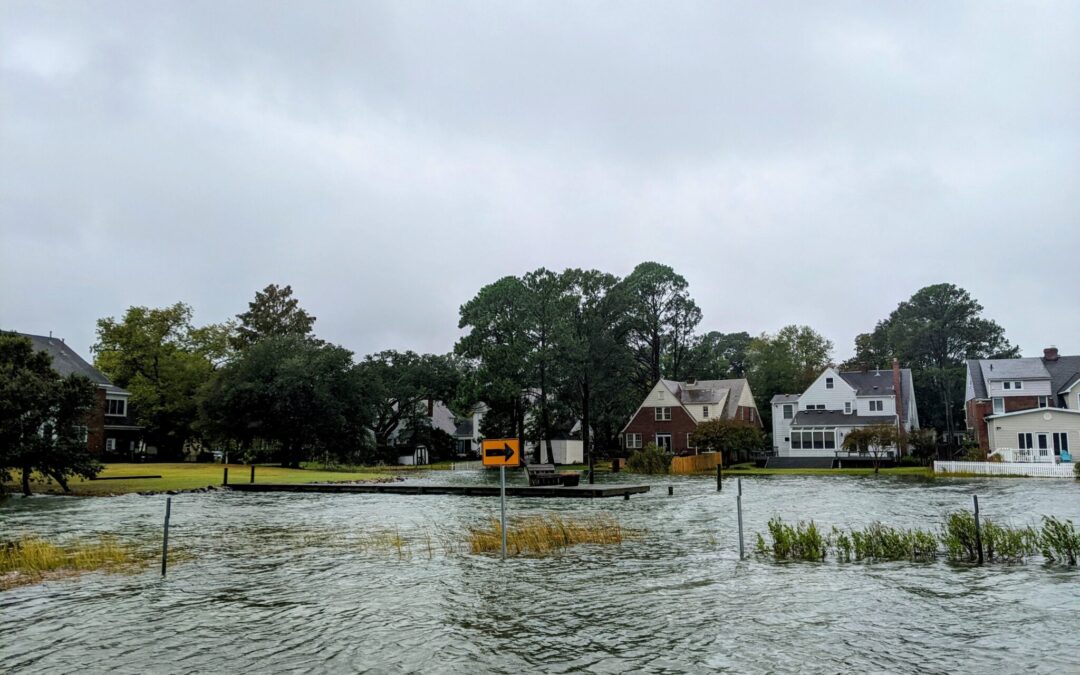By Jim Morrison
As Norfolk’s $2.66 billion storm risk plan moved toward approval by the City Council last spring, residents of the city’s poorer, Black neighborhoods on the Southside grew heated when they learned wealthier neighborhoods would get protective floodwalls, but they would only get natural solutions like grasses and oyster reefs.
The reason was simple: The analysis done by the U.S. Army Corps of Engineers showed their homes weren’t worth protecting with the more expensive concrete walls. For decades, feasibility studies done by the Corps determining what gets protected — and how — have focused on property values. Simply put, the Corps requires the financial benefits of a project to outweigh the costs. Spending what engineers calculated would be $54 million on walls to protect the Berkley and Campostella neighborhoods of Norfolk, where property values were depressed by historical redlining, didn’t come close to meeting the requirement.
The cold analysis backing that conclusion appeared on page 69 of the feasibility study the Corps completed in 2019: “Structural measures do not show economic justification and are not considered reasonable based on the geography of the shoreline.”
Critics have long said its benefit-cost analysis values property over people and grey infrastructure over green solutions to the detriment of disadvantaged communities and the environment.
Now, the agency has proposed a rule change that could dramatically transform how the federal government decides what infrastructure projects it will fund to protect neighborhoods like those in Norfolk. The new approach, which the Corps hopes to have approved by year’s end, would consider not only financial metrics but also projects’ social and environmental benefits — even if they cannot be measured.
The impacts of the change, if approved, would ripple across flood protection projects throughout the country. In response to the climate crisis, the Corps is preparing storm risk plans for numerous Atlantic and Gulf Coast cities including New York, Miami, Boston, Hampton and Newport News, Virginia Beach, and Collier County (Naples), Florida. (New York and Miami have rejected draft proposals by the Corps, and the process is starting over in those cities.)
“It’s an incredibly big deal. It literally affects federal water projects across the nation for decades to come. And that’s probably billions, hundreds of billions of dollars,” said Melissa Samet, the National Wildlife Federation’s senior water resources counsel, who has been following the policy change, the first proposed by the Corps since 1983.
Other federal agencies include social and environmental benefits in their analyses of whether it’s worth embarking on a project. Norfolk’s Ohio Creek Watershed Project, funded through a U.S. Department of Housing and Urban Development competition, used a variety of those metrics to justify building a berm and pump station to protect two vulnerable neighborhoods with more than 300 public housing units.
Samet said the Corps’ change has been in the works for years. It relies on congressional authorization in a 2007 water resources bill but got another boost when the Biden administration announced its Justice 40 Initiative, which aims to ensure 40% of the benefits of certain federal projects flow to disadvantaged, underserved and marginalized communities.
A spokesman at the Corps’ Washington office declined an interview request for this story. Michael Connor, the assistant secretary for civil works, discussed the possible change when he was in Norfolk last June to sign the partnership agreement moving ahead with the city’s storm risk plan. “We’re looking at changing the process by which we evaluate projects so that we can recommend projects that serve a larger segment of the community than historically has been done,” he said in an interview at the time.
In a press release about the change, Connor said: “We are committed to integrating economic, environmental, and social benefits into our planning and improving the Corps’ ability to build resilience in a broad range of communities, including rural, tribal, and low-income areas.”
A good start – but the devil’s in the details
Researchers and representatives of environmental groups say they are supportive of the change, but more clarification is needed.
“How do you change project planning so it drives protection and restoration and benefits to communities and the environment and the economy?” Samet asked. ” It’s a shift in thinking, and the agency desperately needs that. But how it plays out will become the actual key.”
Paul Gallay, director of the Resilient Coastal Communities Project at Columbia University, offered qualified support. “It says a lot of the right things, and if used correctly by the Army Corps, it can make the nation’s flood protection planning investments do more for more people,” he said. “Then again, there’s a lot of wiggle room in the language. So the folks who need this reform may have to fight to make it stick in each individual planning process after the rule and the guidance goes into effect.”
For the proposed rule to be effective, Gallay said the Corps needs to be better about reaching out to local communities, something that was lacking in Norfolk.
“The Corps has got to open the door, welcome the communities into the planning process, and support a more meaningful dialogue and greater accountability to what the communities are bringing to the table,” he added.
For Rob Young, director of the Program for the Study of Developed Shorelines at Western Carolina University, the rule’s lack of quantifiable metrics on environmental and social benefits is one of its strengths.
“My biggest fear was that we would try and fix this by forcing the Corps to quantify environmental benefits or, even worse, social benefits or social equity,” said Young, who has been a persistently vocal critic of the Corps’ cost-benefit analysis, referring to it as “smoke and mirrors.” “So I think that allowing for qualitative reasons to drive some of these projects is absolutely the way you have to do it. Now, of course, you have to establish a framework or a policy for how that’s gonna work. The proof is in the pudding.”
Young said he is willing to roll the dice even though the proposed policy has wiggle room. “This would move things in the right direction. It would allow us to spend public dollars on things that we value as a country beyond just wealth or property values,” he added. “Which, of course, is the way that it should be.”
Rob Moore, director of flooding solutions and environmental health at the Natural Resources Defense Council, agrees.
“If government agencies don’t stop relying so heavily on benefit-cost analysis, the only places that are going to get resources to cope with the impacts of climate change are the places that have the most resources to begin with,” he said. “For climate resilience and adaptation efforts, these ‘benefit-cost analyses’ predictably conclude that areas with lower property values are less worthy of assistance, and that is just fundamentally wrong.”
But Leonard Shabman, a senior fellow at Resources for the Future, a think tank that helped pioneer the field of environmental and natural resource economics, worries vague language will make funding decisions even more political. Army Corps projects, which he has tracked for decades, are unusual because they require individual congressional approval, he noted.
“How they’re going to make a decision beats me. I don’t have a clue,” he said. “There’s always been a tendency to try to come up with something that independent people can look at and say, ‘I may not like the way you did the calculations, but I get the decision rule.’ And now there’s no decision rule. It’s going to be a free-for-all. And it’s going to empower Congress to decide what gets built and what doesn’t. It’s going to loosen up the things that get into the hopper. So more stuff is going to be proposed and what comes out is going to be a power play.”
“You’ve got to have metrics and ways to measure it, or it simply becomes one person announcing this is an environmental justice project, and suddenly it becomes one when it’s not,” he added, although he noted he is not against the rule change.
What’s next for Norfolk?
One consequence of the new rules, said Shabman, may be that nature-based solutions are brushed aside by communities that “want a big wall just like those rich people.”
That’s what happened on the Southside of Norfolk, where residents want a wall and not just the expansion of grasses and elevation of houses. After angry neighborhood leaders raised their concerns, the city added a resolution to its approval of the plan promising to pursue a reevaluation of the protections planned for the Southside.
Could the rule bolster the case for changes to the Norfolk plan? A Corps spokesman pointed out that the proposed rule would apply only to plans or projects initiated after it takes effect, or those that have not issued a draft environmental impact statement. That would mean the new approach wouldn’t apply to completed plans like those in Norfolk or Charleston.
Still, it’s not clear whether the Southside study, if authorized, could be considered a new project. A spokesman for the Norfolk District office of the Corps said the request to reconsider solutions for the neighborhoods is under review at the North Atlantic headquarters.
Residents were told that if the review is approved, the subsequent study evaluating changes could take three years and require congressional authorization for any additional funding needed. If a change is approved, construction of walls could begin in 2032.
Whether or not the rule applies to a revised Norfolk storm risk plan, a change in the cost-benefit analysis would mean residents in other low-income areas nationwide could have a bigger say in how the Corps builds flood protection projects.
For Gallay, that goal crosses party lines. “Flood risk reduction is not a partisan issue. Flooding threatens everyone,” he said. “This more balanced approach to finding the most effective solutions will lead to the greatest good for the greatest number. But communities that have gotten the short shrift in the past will have to stay vigilant to ensure this rule goes into effect and delivers on its promise.”
This report republished courtesy of VirginiaMercury.com




